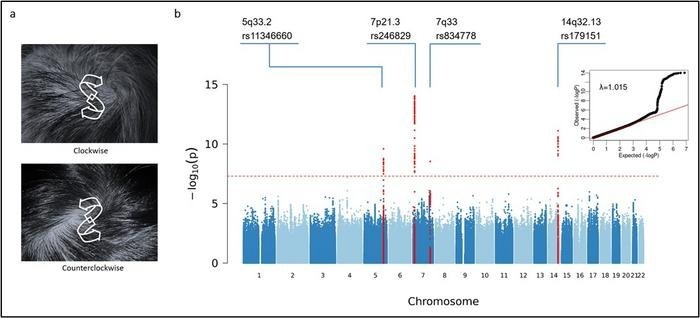The first gene mapping study on human scalp hair whorls not only demonstrates that hair whorl direction has a genetic basis but also that it is influenced by multiple genes. Elsevier’s Journal of Investigative Dermatology has identified four associated genetic variants that are significant in influencing hair whorl direction.
 a) Patterns of whorl direction. (b) Manhattan plot and quantile-quantile plot from the discovery and replication cohorts. Image Credit: Journal of Investigative Dermatology.
a) Patterns of whorl direction. (b) Manhattan plot and quantile-quantile plot from the discovery and replication cohorts. Image Credit: Journal of Investigative Dermatology.
A hair whorl is a circular patch of hair that grows around a point defined by hair follicle orientations. Scalp hair whorl pattern is a readily observable human trait that is typically defined by whorl number (single or double whorl) and whorl direction (e.g., clockwise, counterclockwise, or diffuse).
Understanding the genetic basis of whorl patterns may help unravel important biological processes since atypical whorl patterns have been noticed in patients with abnormal neurological development.
The first genome-wide association study (GWAS) on human scalp hair whorls was conducted on 2,149 Chinese people from the National Survey of Physical Traits cohort, followed by a replication study on 1,950 Chinese people from the Taizhou Longitudinal Study cohort.
We know very little about why we look like we do. Our group has been looking for the genes underlying various interesting traits of physical appearance, including fingerprint patterns, eyebrow thickness, earlobe shape, and hair curliness. Hair whorl is one of the traits that we were curious about.
Sijia Wang, Lead Investigator, Shanghai Institute of Nutrition and Health, Chinese Academy of Sciences
Sijia Wang adds, “The prevailing opinion was that hair whorl direction is controlled by a single gene, exhibiting Mendelian inheritance. However, our results demonstrate that hair whorl direction is influenced by the cumulative effects of multiple genes, suggesting a polygenic inheritance.”
The research pinpoints four related genetic variants (at 7p21.3, 5q33.2, 7q33, and 14q32.13). By controlling the cell polarity of hair follicles, these genetic variations are likely to affect the direction of the hair whorls. Closure and growth of the cranial neural tube may also be affected.
While previous work proposed the hypothesis of associations between hair whorl patterns and abnormal neurological development, no significant genetic associations were observed between hair whorl direction and behavioral, cognitive, or neurological phenotypes. Although we still know very little about why we look like we do, we are confident that curiosity will eventually drive us to the answers.
Sijia Wang, Lead Investigator, Shanghai Institute of Nutrition and Health, Chinese Academy of Sciences
Source:
Journal reference:
Peng, F., et al. (2023). GWAs Identify DNA Variants Influencing Eyebrow Thickness Variation in Europeans and Across Continental Populations. Journal of Investigative Dermatology. doi.org/10.1016/j.jid.2022.11.026.